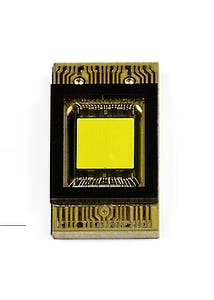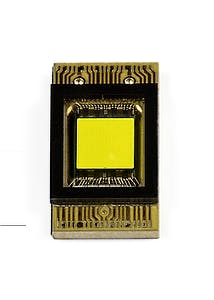Automotive LED headlamps have proven to deliver new capabilities such as steering the projected light beam based on the road contour and oncoming traffic, but a new Osram design ups the ante with 1024 individually controllable emitters.
Osram Opto Semiconductors has announced a new development in automotive headlamps in which a thumbnail-sized packaged LED integrates 1024 individually-controlled emitters. The new headlamp technology comes courtesy of a partnership between Osram, the Fraunhofer Institute for Reliability and Microintegration (IZM), semiconductor-manufacturer Infineon, auto third-party OEM Hella, and auto manufacturer Daimler with funding from the German Federal Ministry of Education and Research (BMBF).
Interested in articles & announcements on automotive LEDs?
LED headlamps have become increasingly popular in the past few years due to styling, durability, and energy efficiency. Even mainstream vehicles often support solid-state lighting (SSL) either for the main headlamp and/or daytime running lights. And Osram has been a key player in the space. Indeed, we covered the launch of the popular Ford F-150 pickup truck in North America in 2014 when it was announced that Osram had partnered with the auto maker on an LED headlamp.
Still, LEDs offer potential advantages that go way beyond styling. Adaptive designs could essentially eliminate the need for low beams by steering the light in a way that ensures the light does not impact oncoming drivers. Such products are only found on luxury vehicles today and only in Europe, and we covered the launch of the Audi Matrix technology back in 2013.
Osram and partners Faunhofer, Infineon, Hella, and Daimler are developing new LED headlamps that utilized a packaged LED integrating more than a thousand individual emitters.
The new technology developed by Osram and its partners will create even more flexibility in terms of keeping light out of the eyes of oncoming drivers, and placing the light in places that best allow the driver to see pedestrians and obstacles. The aforementioned 1024 LED sources are all integrated in what Osram describes as a thumbnail-size chip — although the word chip implies a monolithic IC or integrated circuit. The Osram chip appears to be either a small printed circuit board, or perhaps what is sometimes called a hybrid device because it is utilized in the fashion of an IC but can include multiple analog or digital semiconductors integrated on a reliable substrate. A typical headlamp design might use three of the chips in each headlamp. Indeed, the partners have produced a module with just such a design.
In the partnership, Hella and Daimler defined the functional requirements for the headlamp. But basing a headlamp module on such a complex chip is fraught with problems. For instance, with so many emitters integrated, one or more is likely to fail on many chips, and driving and controlling 1024 individual light sources requires complex electronics.
Infineon helped solve the driver and control problem, working to integrate the electronics on the same chip with the LEDs. Fraunhofer, meanwhile, developed a methodology based on ultraviolet (UV) laser micromachining that allows defects in the emitter array to be fixed during the manufacturing process. And the partners have demonstrated that the technology development works.
The module, according to Osram, would adapt continuously based on factors such as weather conditions, speed, traffic, and route. Presumably intensity would be turned up and the beam narrowed on highways at high speed. In cities the module would produce a wider pattern to light sidewalks and peripheral areas.
Now the partners will look to commercialization. "We now want to develop this new type of high-resolution LED light source so that it’s ready for serial production and we see enormous potential for its use in headlights," said Stefan Kampmann, CTO of Osram.







